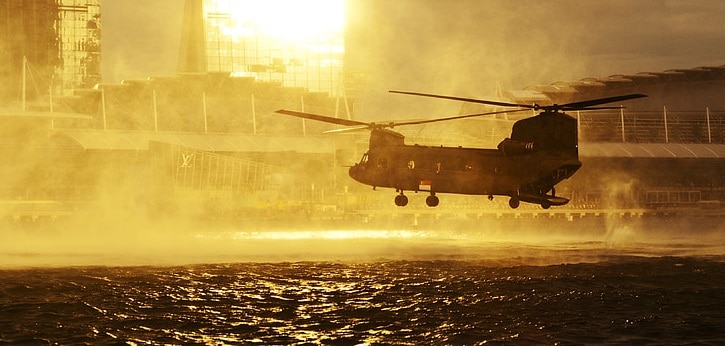
I’m sure you have seen video footage of the coast guard helicopter hovering over the water while a diver jumps in to rescue a stranded swimmer. Why do they not just land on the water and pick them up? I know I have seen some helicopter land on water so it can be done, can’t it?
Only helicopters with specially designed & sealed fuselages, or helicopters fitted with fixed or emergency popout floats can land on water. Helicopters have a high center of gravity caused by the engine & transmission which causes them to topple over. Only helicopters with fixed floats do not topple.
Although not very common, helicopters that operate for the majority of their time over water will have some kind of design feature that will allow them to safely land on water. To find out more about these design features please read on…
Are There Any Helicopters Designed To Land On Water?
During the 1950s & ’60s, several helicopter manufacturers began designing helicopters that could land on water as part of requests from the Navy. Some of these helicopters were to be used in Anti-Submarine Warfare and Troop extraction.
Most of the design modifications included ‘Boat-Like’ hull shapes, pontoons on outriggers, and sealed buoyancy compartments to help keep the helicopter afloat and upright during operations. By far the most iconic amphibious helicopter is the Sikorsky S-61:
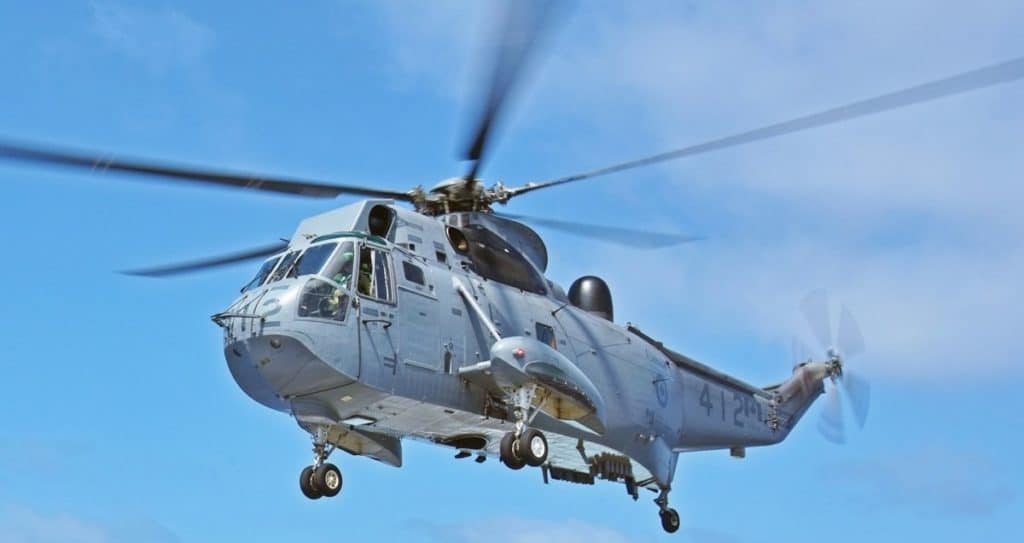
Here are some other helicopters designed to land on water:
(Links to Wikipedia)
- Sikorsky HH-3F Pelican – U.S. Coast Guard (S-61 Variant)
- Sikorsky CH-47 – Chinook
- Sikorsky CH-53 – Sea Stallion
- Mil Mi-14 – Haze
Due to the complexity and limited operations of water landings, the designs never really evolved into commercial helicopters. The Chinook, Pelican, and Sea Stallion are about the only helicopters operating today that use their amphibious hulls for rapid troop deployment/extraction.
There are however additional systems that can be retrofitted to helicopters to allow for water-based operations and landings.
Can Helicopters Use Floats To Land On Water?
Helicopters can be fitted with a flotation system to help them land on water. There are two main types available:
- Fixed Utility Floats
- Emergency Pop-Out Floats
Each type has a very different purpose and depending on what the helicopter operator requires will depend on which type of flotation system is installed.
Fixed Utility Floats
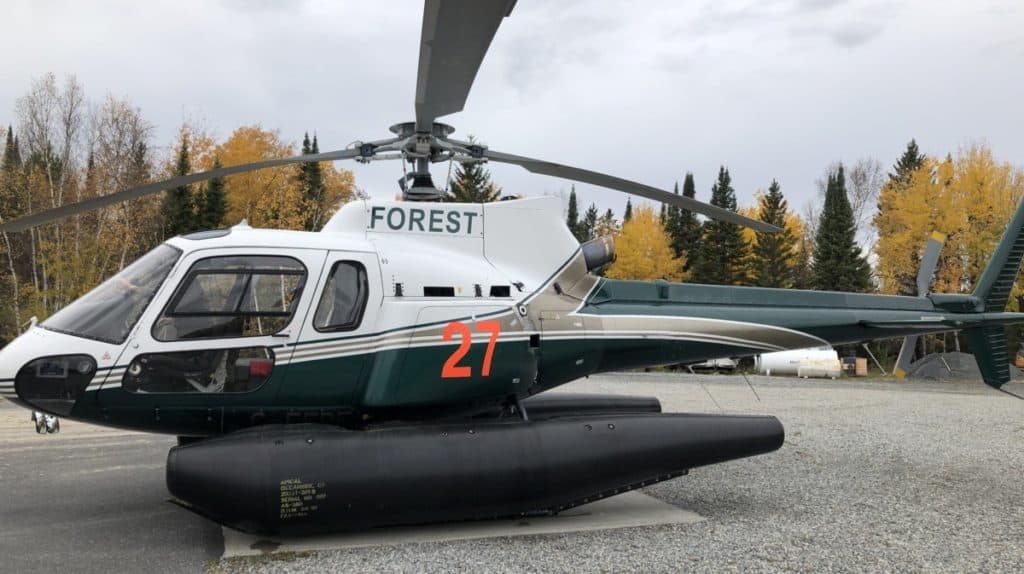
These utility floats are an easily removed/installed inflatable airbag system that can be purchased as a kit for specific helicopters. They are mainly available only for light helicopters weighing up to around 5000lbs.
Each float consists of 4 airbags: two on the front and two on the back within each unit. This provides redundancy in case one of the internal airbags begins to lose air pressure.
The utility floats are fitted to an aircraft when work over water or swampy areas requires the temporary use of floats. Water sampling surveys are the most common use for when we use our fixed utility floats. The great thing about these floats is that they are designed to allow the aircraft to land and shut down without the chance of the helicopter overturning.
These floats are limited to Sea State 1 (waves <6″) and are easily filled using a simple air pump with pressure relief valves to prevent over-pressurization when altitude or temperature changes. They are a really simple, yet effective piece of equipment!
Although fixed utility floats are great for specialist work, depending on the model they can really limit the speed of the helicopter, the weight it can carry inside, and sling loads are prohibited from being carried on the belly hook while they are fitted.
Pilots have to pay special attention when shutting down and starting up the engine in open water as the helicopter can rotate up to one complete revolution while the rotor system spools up and down. When on land, the friction between the ground and the skids (landing gear) prevents the helicopter from rotating while spooling up or down.
However, when a helicopter has landed on water, the friction between the floats and the water is minimal thus allowing the thrust from the turning tail rotor to push the helicopter around. Once the engine is up to flight RPM the pilot will have full directional control of the helicopter.
Until the pilot has full control there can be problems if they have not left enough room for the helicopter slowly rotate on the water and the tail rotor makes contact with an object. Wind can also drift the helicopter if it’s not tied down or anchored. The best way to take off in a helicopter that has fixed floats is to plan the landing so that the aircraft is on the upwind side of the waterbody and anchor off.
When it is then time to depart the pilot allows the wind to push the helicopter into a clear area of the water and then start the engine.

Join My Newsletter & Get Great Tips, Information and Experiences To Help You Become a Superb Pilot!
Emergency Pop-Out Floats
Floats are a great device to have but they are ugly, cumbersome, limit some of the functions a helicopter can do and there is no graceful way to climb over them to get inside the helicopter. You can guarantee no VIP would be doing that!
The second kind of system that allows helicopters to land on water is the emergency pop-out floatation kits. These kits are like airbags in your car. The deflated airbags are tucked away in hidden compartments or exterior pouches and are connected to a gas bottle and a firing system.

When a helicopter has to make an emergency landing to water the pilot can either:
- Arm the system and then the detection of water automatically inflates the airbags, or
- The pilot activates the inflation via a button on the collective or cyclic controls.
When the activation system activates a valve opens on the pressurization bottle (usually filled with nitrogen) and the gas instantly fills the airbags very rapidly. See the video below:
Just like the fixed utility floats, each individual airbag is made up of two chambers. If one chamber develops a leak, the other chamber will prevent that part of the helicopter from sinking.
This system allows the helicopter to land on water and provides enough time for the occupants to evacuate into a life raft. Because of the narrow width between the floats, it is not uncommon for a helicopter to overturn, especially in rough water.
The whole purpose of the pop-out float system is to be there if needed and then to allow for escape. If the helicopter owner is lucky enough the helicopter remains upright until recovery of the aircraft can take place.
Why Do Helicopters Sink?
Most helicopters will roll upside down and sink within seconds of landing on water due to their high center of gravity from the transmission, engine/s, and rotor system mounted above the cabin. Emergency floatation bags can keep a helicopter upright long enough for the occupants to safely evacuate.
If a pilot in a helicopter that is not fitted with the equipment mentioned above tries to land on water it would immediately capsize, roll onto its roof and begin to sink.
To make helicopters more ‘Roomy’ for their passengers the designers place all the big stuff on top of the cabin roof. The main transmission, engine/s, hydraulic systems, and HVAC system (if fitted) are mounted above the cabin. This achieves several things:
- Provides for a bigger passenger cabin
- Allows the cabin to be structurally strong to improve crash protection
- Allows the cabin to be sound and vibration proofed from the noisy stuff
- Allows maintenance engineers easy access
This raises the helicopter’s Center of Gravity and makes the helicopter very top-heavy. This is not a problem when the helicopter is on the ground as the skids or wheels give the helicopter a wider footprint to sit on.
As soon as the helicopter touches down on water, the skids or wheels are unable to provide that wide footprint because of the viscosity of the water.
Once the aircraft begins to lean and its Center of Gravity goes past the edge of the aircraft floor, it will turn over and begin to sink.
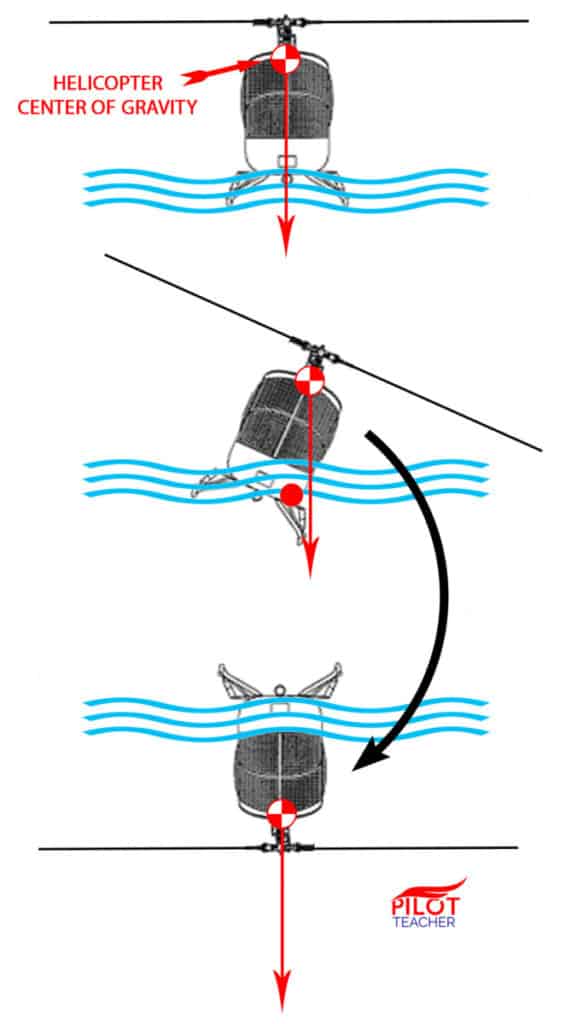
This layout is mainly applicable for the larger helicopters that carry more than 4 passengers, but the main thing to understand here is where the weight of the majority of the helicopter is – and that is towards the top of the aircraft. This makes the center of gravity of the helicopter higher than its waterline if it lands on the water. A boat stays upright because its center of gravity (CofG) sits low to its waterline, but because the helicopter’s CofG is high this will cause it to roll over within seconds of touchdown on the water.
Once the helicopter has rolled over, its cabin will soon begin to fill with water. While the cabin is filling with water it will contain air that will keep the helicopter from sinking, but once the cabin is completely filled with water, the air is displaced and the weight of the transmission, engines, and rotorhead will cause the helicopter to sink.
To prevent this from happening the helicopter needs to be fitted with floats or the boat hull design to provide enough time to allow the occupants to make a safe evacuation.
To Finish
Helicopters can land on water with the aid of the fuselage design or floatation bags. Depending on the size of the aircraft the flotation bags will either be able to be easily removed or permanently installed.
When an aircraft is unable to glide to a shoreline when operating over water it needs to carry at least an emergency liferaft and life jacket for each occupant. Having an additional float system fitted really helps ease any anxiety a passenger, pilot, or owner may have.
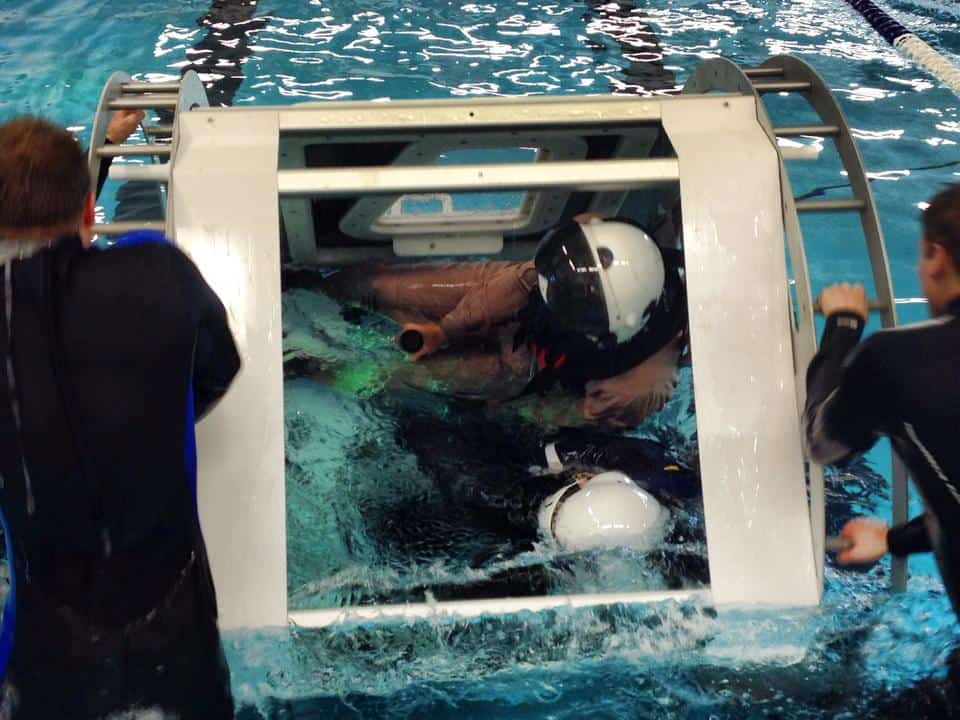
I have done the underwater escape training course and I can tell you that trying to escape from an upturned helicopter is almost impossible without the training! Floats give EVERYONE the opportunity to complete their overwater work safely or get out in an emergency!
Further Reading
If you found this article interesting and would like to keep reading, I highly recommend the following articles from my blog:

